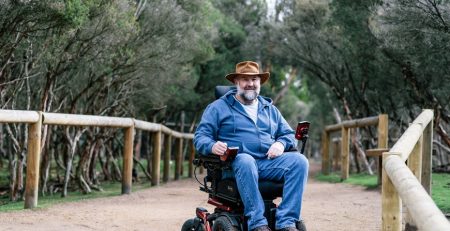- No products in the cart.
Hobbies that are wheelchair friendly
As unfortunate as it is, individuals may no longer participate (or engage much less) in activities they love as they age. Your abilities change with time and individuals may experience decreased endurance, difficulty walking, pain in various body parts, changes in vision, and lack of strength in their upper or lower body.
Some of these issues may present themselves in a mild way as someone ages, but most often these changes are attributed to health concerns. Health concerns may also require someone to use a wheelchair, either on a part-time or full-time basis. Individuals with difficulty getting around may need a wheelchair part-time, meaning only when their pain or strength is especially bad. An example of a full-time wheelchair user is someone who has suffered from a spinal cord injury (SCI) or a stroke (CVA) that has left them without any feeling or movement in their lower body.
Individuals use wheelchairs for a variety of reasons, but this does not exclude them from participating in either previously enjoyed hobbies or new activities of interest. Wheelchair users can engage in a range of typical or adapted leisure activities to assist in maintaining their quality-of-life and general well-being. Here are a few examples:
Gardening
Working outside can be strenuous on anyone’s joints. A wonderful way to participate in gardening while preventing any undue stress on the body is to use raised beds. These beds house dirt in a large wooden box that is raised several feet off the ground. Individuals can plant anything in raised beds that they would plant directly into the ground (flowers, container plants, or plants that grow under the soil), but with the added bonus of accessing them much easier by remaining protected in their wheelchair, a regular chair, or while standing up.
This offers individuals improved circulation (if they are able to stand out of their wheelchair and work out of the bed) as well as ergonomic positioning that keeps the body’s joints aligned and the muscles loose and flexible. Wheelchairs can be pulled right up to the raised bed and tools can be stored nearby on a table or in a wheelchair pouch for convenience and added joint protection.
Tabletop tasks
The list goes on and on for this category, as many tabletop activities are a great fit for someone in a wheelchair. Some seated tasks include:
- Coloring, painting, or drawing
- Knitting
- Jewelry making
- Wood working
- Model making
- Stenography
- Journaling
- Reading
- Playing board games
These tasks can easily be completed by rolling up to the nearest table that accommodates the height of your wheelchair. If you are a part-time wheelchair user and want to engage in some of these activities (such as knitting or reading) for a longer period of time, you may be more comfortable moving over to a couch and using a small tray table as needed. However, individuals that opt for tasks involving the use of a utensil (coloring, drawing, journaling) or detailed, tedious work (such as model making or jewelry making) would be best suited at a table where they can achieve an ergonomic position to prevent pain and stiffness.
Most of these activities require prolonged use of the hands, meaning all individuals should take the appropriate measures to protect these small, fragile joints. Anyone who is working with their hands for an extended period of time should be sure to stretch their fingers, wrists, and shoulders every 15-20 minutes to ensure sufficient blood flow and muscle function.
Photography
Taking pictures is another great wheelchair-friendly hobby. Not only does photography allow you to document your life and the lives of those around you but it also makes you an active part of social events. Some individuals may choose to combine their love of nature or still life with photography and opt for this as a more solitary task. Either way, individuals in wheelchairs can engage in this leisure activity.
Nature
A range of hobbies involve nature, including using relatively flat hiking or biking trails, bird watching, or simply spending time outdoors in parks or on beaches. Individuals in wheelchairs should be sure their tires can accommodate such terrain (by either getting treads or replacement wheels that are better suited for outdoors) but can actively enjoy a variety of landscapes. Another great way to immerse yourself in nature is by fishing. Fishing can easily be done in a wheelchair with a little practice for the height adjustment. Individuals can even use wheelchair pouches and storage to assist in holding bait, lures, fishing reel, and more. This will make their experience more enjoyable and convenient.
Billiards
Basketball may be the primary activity that comes to mind when people think of wheelchair-friendly sports. While this is a great way to stay active and learn the value of teamwork, billiards is perhaps a lesser known hobby that is accessible to individuals in wheelchairs. Billiards allows individuals to use their arms and build upper body strength to wheel around the entire table and use coordination to aim, hit, and sink balls. Individuals may find themselves needing to lock their brakes and boost themselves slightly up in their chairs to get the best angle for a certain shot. However, this is still a primarily seated activity that can keep individuals in wheelchairs active and enjoying social environments such as bars, friend’s homes, and even practicing within their own rec room.
Video games
Another hobby that is somewhat related to tabletop activities is video games. There is quite a bit of variety found within the realm of video games, as individuals can experiment with computer games, console games (hooked up to their TV), handheld games, and even certain virtual reality (VR) games. Each of these mediums of video games offers genres such as strategy games, puzzles, racing games, action games, role-playing games, and more. In healthy doses, video games are an excellent way to enhance hand-eye coordination, improve dexterity of the fingers, and maintain endurance. The use of video games can also improve your ability to use your wheelchair by giving you more strength and motion in the upper body to manipulate brakes, self-propel, reposition yourself in the wheelchair, and transfer in and out of the chair (if you are able to).
As with tabletop games, individuals who play video games should be sure to stretch often while playing, since this can give the upper body quite a bit of stress when playing for an extended period of time. It’s a good idea to incorporate a brief but sustained stretch to the fingers, wrists, and shoulders every 15-20 minutes to ensure sufficient blood flow and muscle function.
These are just some of the ways that individuals in wheelchairs can have an active leisure and social life while strengthening their bodies and minds. As you can see, these activities (and many more) offer much variety and allow individuals to take part in activities that help them build skills and give a sense of competence and achievement. Many additional hobbies and activities can be adapted for use by someone in a wheelchair. If you are interested in learning more about how you can better and more safely engage in hobbies despite your mobility concerns, contact a healthcare or rehabilitation professional such as an occupational or recreational therapist.















